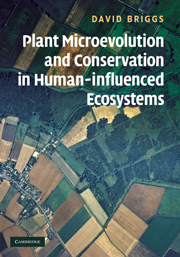Book contents
- Frontmatter
- Contents
- Preface
- Acknowledgements
- List of abbreviations
- 1 Introduction
- 2 Studying change
- 3 Key concepts in plant evolution
- 4 The origin and extent of human-influenced ecosystems
- 5 Consequences of human influences on the biosphere
- 6 Categories
- 7 Investigating microevolution in plants in anthropogenic ecosystems
- 8 Plant microevolution in managed grassland ecosystems
- 9 Harvesting crops: arable and forestry
- 10 Pollution and microevolutionary change
- 11 Introduced plants
- 12 Endangered species: investigating the extinction process at the population level
- 13 Hybridisation and speciation in anthropogenically influenced ecosystems
- 14 Ex situ conservation
- 15 In situ conservation: within and outside reserves
- 16 Creative conservation through restoration and reintroduction
- 17 Reserves in the landscape
- 18 Climate change
- 19 Microevolution and climate change
- 20 The implications of climate change for the theory and practice of conservation
- 21 Overview
- References
- Index
17 - Reserves in the landscape
Published online by Cambridge University Press: 05 June 2012
- Frontmatter
- Contents
- Preface
- Acknowledgements
- List of abbreviations
- 1 Introduction
- 2 Studying change
- 3 Key concepts in plant evolution
- 4 The origin and extent of human-influenced ecosystems
- 5 Consequences of human influences on the biosphere
- 6 Categories
- 7 Investigating microevolution in plants in anthropogenic ecosystems
- 8 Plant microevolution in managed grassland ecosystems
- 9 Harvesting crops: arable and forestry
- 10 Pollution and microevolutionary change
- 11 Introduced plants
- 12 Endangered species: investigating the extinction process at the population level
- 13 Hybridisation and speciation in anthropogenically influenced ecosystems
- 14 Ex situ conservation
- 15 In situ conservation: within and outside reserves
- 16 Creative conservation through restoration and reintroduction
- 17 Reserves in the landscape
- 18 Climate change
- 19 Microevolution and climate change
- 20 The implications of climate change for the theory and practice of conservation
- 21 Overview
- References
- Index
Summary
As we saw in Chapter 15, the first national parks were developed in the nineteenth century. They were the forerunners of many nature reserves and wildlife sanctuaries. As the conservation movement has gathered momentum, in situ management of reserved areas has become the key strategy employed by conservationists in their efforts to secure the future of biodiversity. There are many types of reserves of different sizes: all are fragments within a matrix of surrounding territories that might have different land use. Considering the size, geographical location and ‘connectedness’ of lands set aside for conservation, how far has it proved possible to secure the future of endangered species and ecosystems? Also, what ‘strengths and weaknesses’ have been identified after more than a century of experience in managing reserves?
Reserve design
The theory of island biogeography proposed by MacArthur and Wilson (1967) drew on important earlier research by Preston and others (see Mann & Plummer, 1996). The theory explored the implications of the observation that species richness tended to be low on small isolated islands far from land. In contrast, biodiversity was often greater on large islands close to the mainland. On the basis of these ideas conservationists proposed a number of model systems for reserves and national parks.
- Type
- Chapter
- Information
- Publisher: Cambridge University PressPrint publication year: 2009

